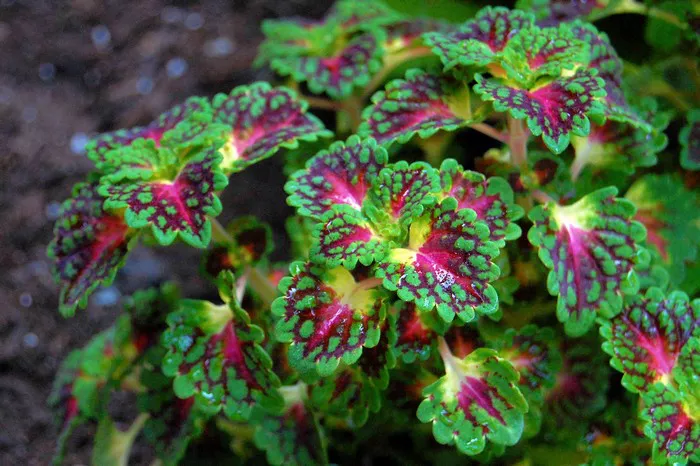Coleus, with its vibrant foliage and striking appearance, has long been admired by gardeners and plant enthusiasts alike. While often grown for its colorful leaves, coleus also produces delicate flowers that add to its allure. In this comprehensive guide, we delve into the anatomy, variations, significance, and cultivation of coleus flowers, shedding light on their captivating characteristics.
Anatomy of Coleus Flowers
Coleus flowers, though not as prominent as their foliage, possess a unique beauty of their own. They typically feature small, tubular blooms that emerge from the tips of the plant’s stems. These flowers can vary in color, ranging from shades of purple, pink, and white to hues of yellow and red. While individually modest in size, coleus flowers often appear in clusters, creating a visually striking display amidst the lush foliage.
The structure of a coleus flower consists of several key components. At the center of the bloom is the pistil, the female reproductive organ responsible for receiving pollen. Surrounding the pistil are the stamens, the male reproductive organs that produce and release pollen. Together, these components facilitate the process of pollination, enabling the plant to reproduce and produce seeds.
The petals of coleus flowers, though small, contribute to their overall appearance. While some varieties may have petals with smooth edges, others feature petals adorned with intricate patterns or serrated edges, adding to the visual interest of the blooms. Additionally, the presence of nectar glands within the flowers serves as an attractant for pollinators such as bees and butterflies, further enhancing their ecological significance.
Variations in Coleus Flowers
One of the most captivating aspects of coleus flowers is the wide array of variations found within the species. From subtle differences in coloration to unique patterns and shapes, coleus enthusiasts can find endless possibilities when selecting cultivars for their gardens.
Color variation is perhaps the most notable feature of coleus flowers. While some cultivars boast bold, solid hues, others exhibit intricate combinations of colors, creating a kaleidoscope of tones within a single bloom. Varieties such as ‘Rainbow Mixed’ and ‘Kong Rose’ showcase the diverse palette of colors available, ranging from deep purples and rich greens to vibrant oranges and bright yellows.
In addition to color, coleus flowers also vary in size and shape. While most blooms are relatively small and tubular in form, certain cultivars may produce larger or more elongated flowers, adding to the visual diversity of the species. Varieties such as ‘Black Dragon’ and ‘Dipt in Wine’ feature elongated flower spikes that stand out against the backdrop of their foliage, creating a dramatic effect in the garden.
Pattern variation is another distinguishing characteristic of coleus flowers. Some cultivars display solid-colored petals, while others feature intricate patterns such as speckles, stripes, or veining. Varieties like ‘Wizard Velvet Red’ and ‘Main Street Oxford Street’ showcase the intricate patterning that can be found within the species, adding an extra layer of visual interest to the blooms.
Significance of Coleus Flowers
Beyond their ornamental value, coleus flowers play a significant role in the ecosystem as pollinator attractants. The nectar produced by the flowers serves as a vital food source for bees, butterflies, and other pollinating insects, helping to support biodiversity and promote ecosystem health. By cultivating coleus plants in gardens and landscapes, individuals can contribute to the conservation of pollinator populations and encourage sustainable gardening practices.
Furthermore, coleus flowers hold cultural significance in various parts of the world. In some cultures, coleus plants are associated with symbolism and tradition, often used in religious ceremonies, rituals, and celebrations. The vibrant colors and lush foliage of coleus plants symbolize vitality, abundance, and prosperity, making them popular choices for decorative purposes during festive occasions.
In addition to their cultural significance, coleus flowers have also garnered attention for their medicinal properties. Certain compounds found in coleus plants, such as forskolin, have been studied for their potential therapeutic benefits, including cardiovascular support, weight management, and respiratory health. While further research is needed to fully understand the extent of these benefits, coleus remains a subject of interest in the field of natural medicine.
Cultivating Coleus Flowers
Cultivating coleus flowers is a rewarding endeavor that offers both aesthetic and practical benefits. Whether grown in containers, hanging baskets, or garden beds, coleus plants thrive in a variety of environments and can be easily incorporated into any landscape design.
To cultivate coleus flowers successfully, it is essential to provide them with the right growing conditions. Coleus plants prefer well-drained soil that is rich in organic matter, with a slightly acidic to neutral pH. They also thrive in partial shade to full shade, making them ideal choices for shady areas of the garden or indoor spaces with limited sunlight.
When planting coleus flowers, be sure to space them adequately to allow for proper air circulation and prevent overcrowding. Water the plants regularly, keeping the soil consistently moist but not waterlogged, to promote healthy growth and flowering. Additionally, fertilize coleus plants periodically with a balanced fertilizer to provide them with the nutrients they need to thrive.
One of the most appealing aspects of coleus plants is their versatility in terms of propagation. Coleus can be easily propagated from stem cuttings, allowing gardeners to expand their collection of plants with minimal effort. Simply take a cutting from a healthy coleus plant, remove the lower leaves, and place the cutting in a container filled with moist potting soil. Keep the soil consistently moist and provide the cutting with bright, indirect light until roots develop, at which point it can be transplanted into its permanent location.
Conclusion
In conclusion, coleus flowers captivate with their intricate beauty and diverse variations. From their delicate blooms to their vibrant foliage, coleus plants add a touch of elegance and charm to any garden or landscape. By understanding their anatomy, appreciating their significance, and mastering their cultivation, gardeners can enjoy the timeless allure of coleus flowers for years to come. Whether grown for their ornamental value, ecological benefits, or medicinal properties, coleus remains a beloved choice among plant enthusiasts worldwide.


